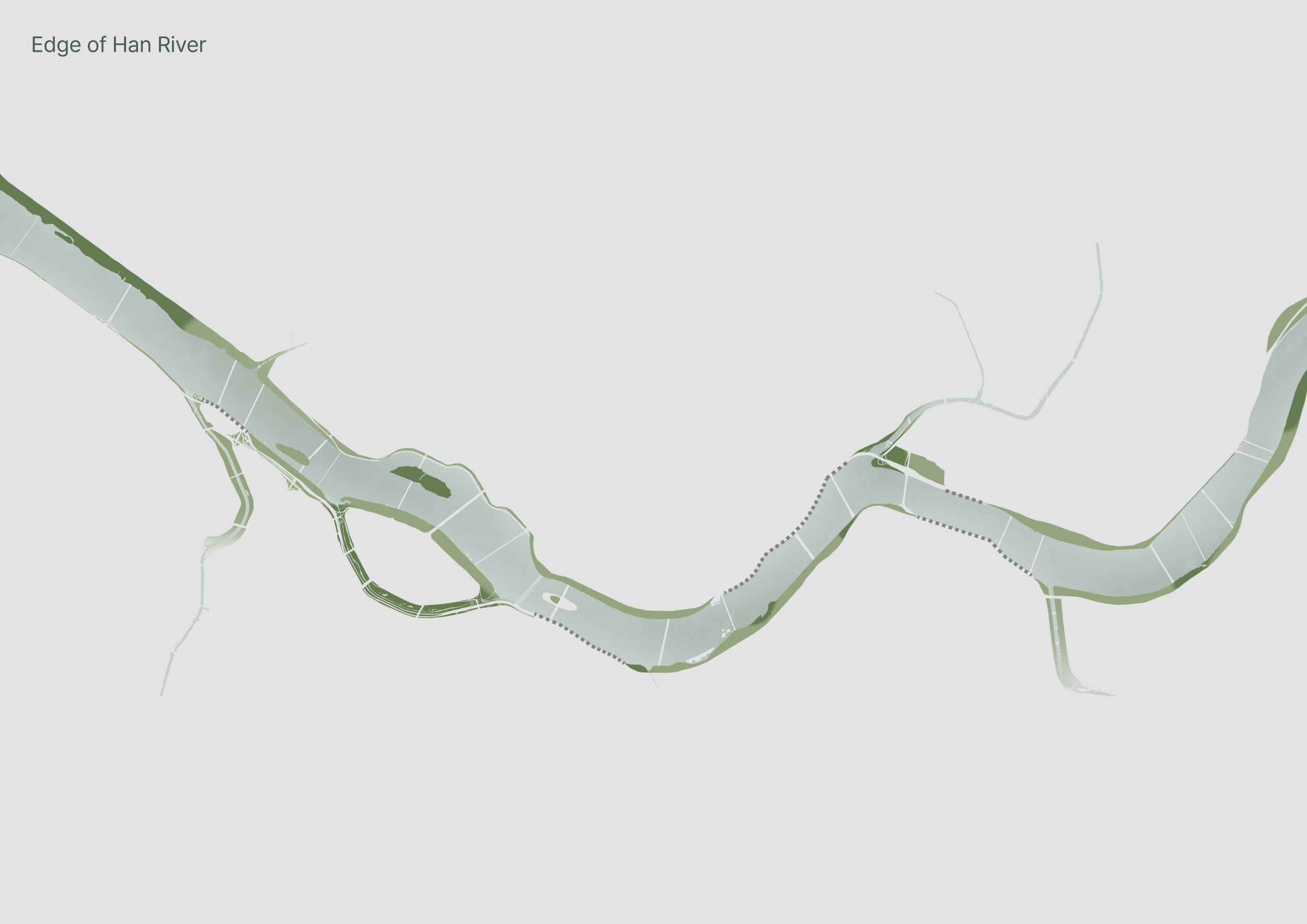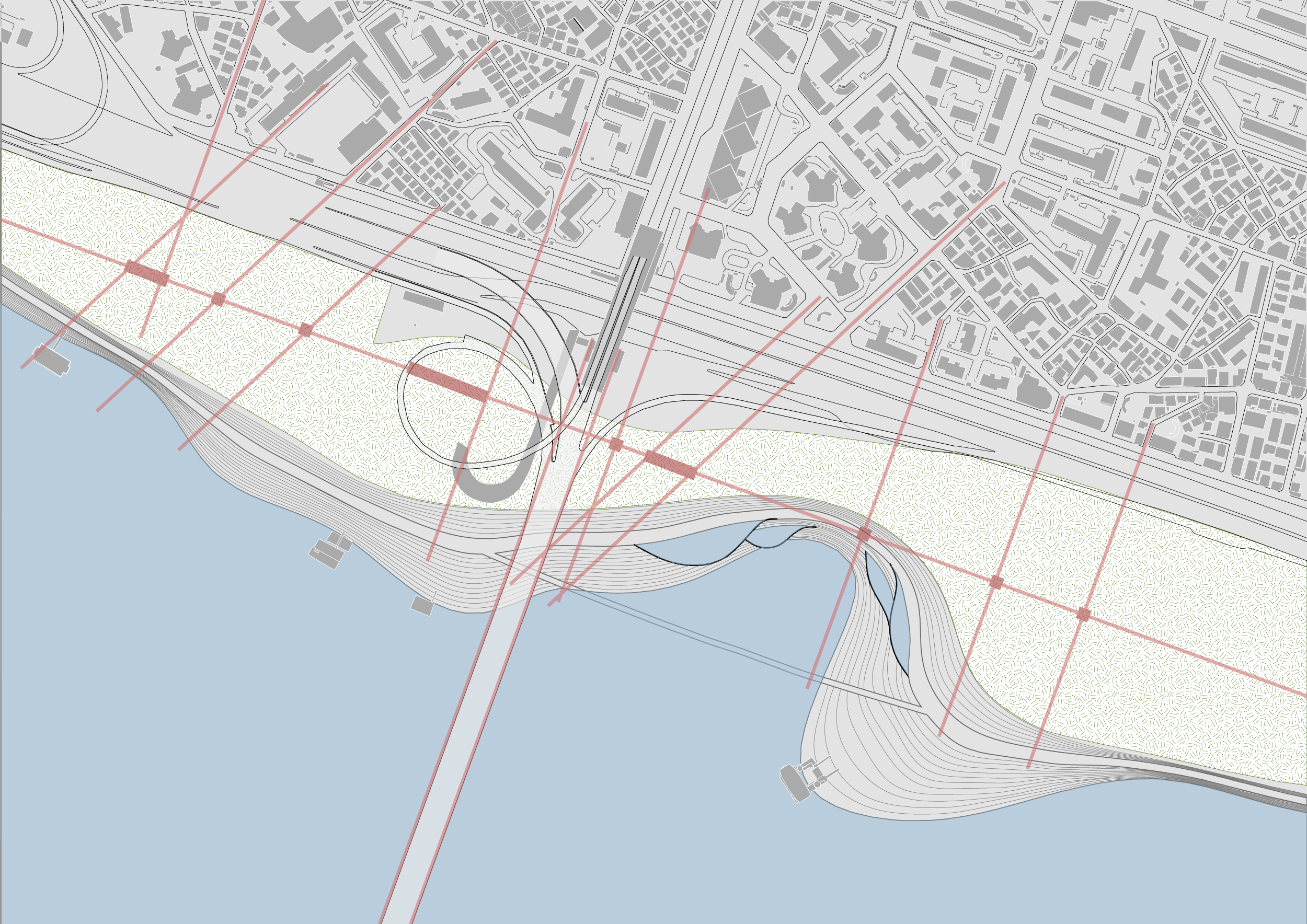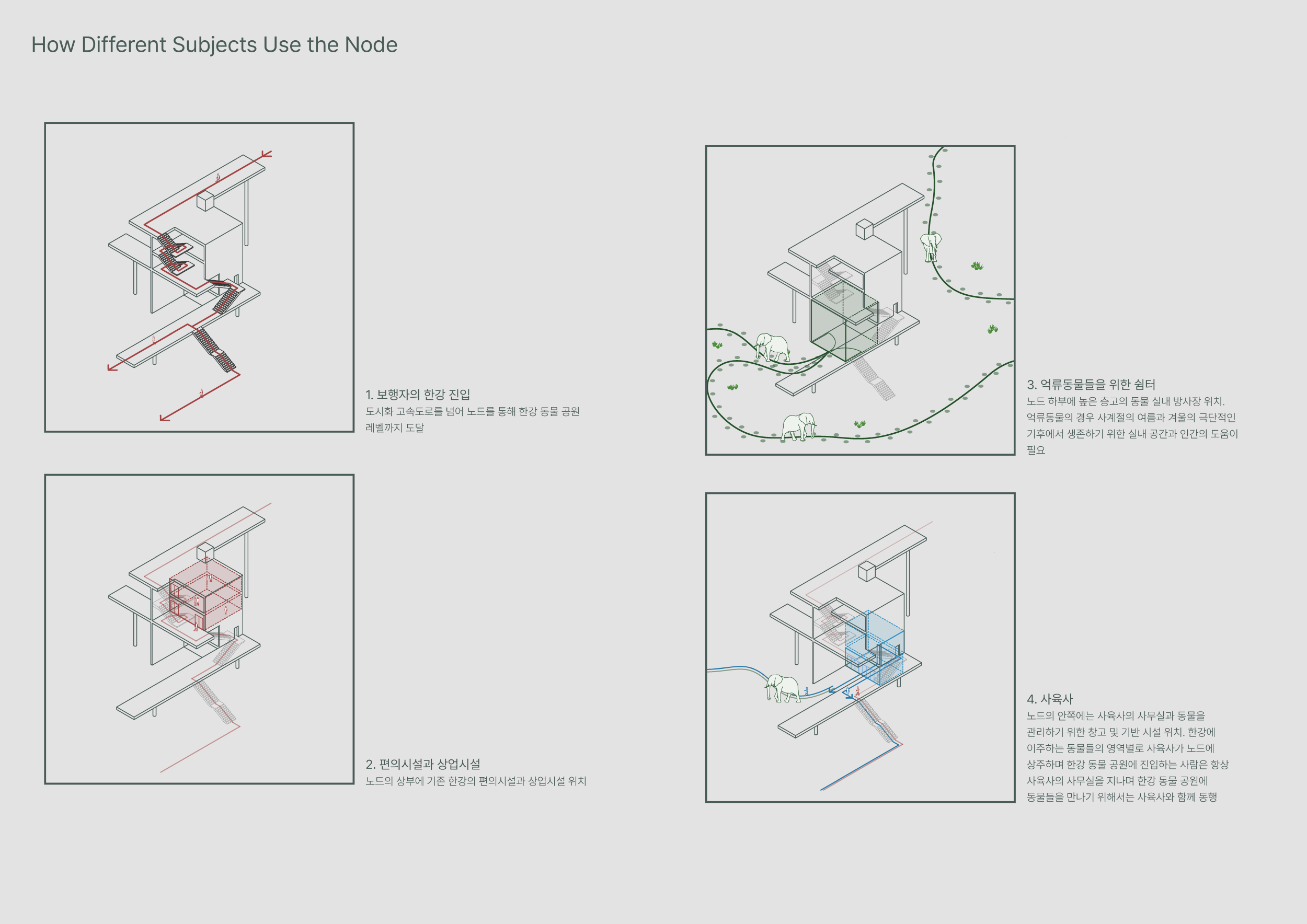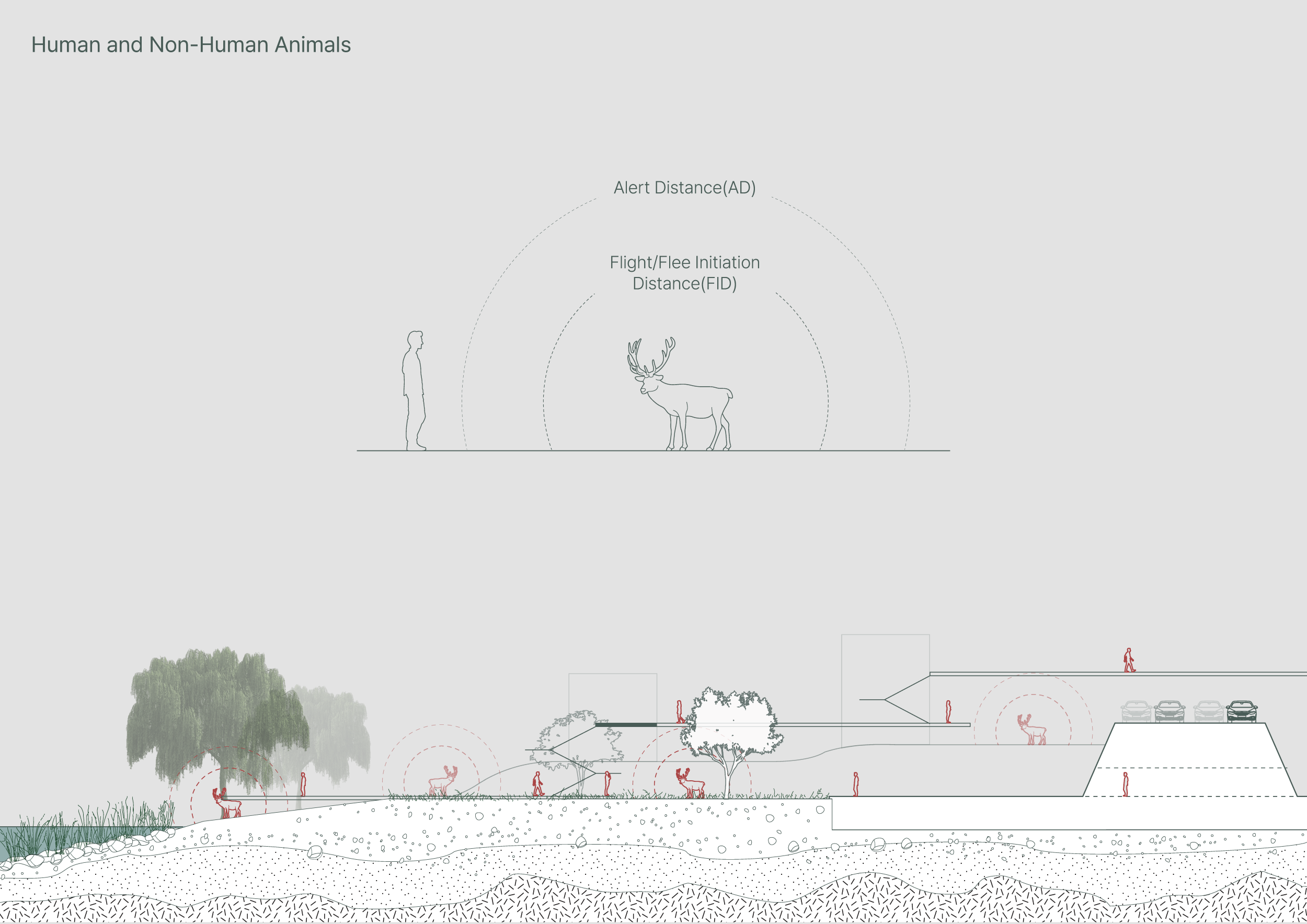김영채_Hangang Animal Sanctuary
도시는 인간-동물들이 자신들을 위해 만들어 놓은 환경이다. 그렇다면 비인간-동물은 어디로 가야하는가.
이 프로젝트는 인간-동물과 비인간-동물이 모두 지구의 공간에 대한 동등한 권리를 가지고 있으며 함께 도시 공간을 공유할 수 있어야한다고 주장한다. 여기에 더해 인간-동물이 비인간-동물을 대하는 태도의 변화, 비인간-동물과 공존하며 살아갈 수 있는 도시 인간-동물들의 생활 방식의 변화를 제안한다.
쉽게 말해 서울이라는 도시에서 살아가는 모든 동물들에 대한 이야기를 하고자 한다.
[동물원]
식민지 시대의 제국주의에서 시작되어 자신의 권력과 부를 과시하기 위해 동물을 수집하고 전시하던 것에서 시작되었다. 이러한 기원에도 불구하고 동물권에 대한 인식이 높아지고 있는 현대에도 동물원이 남아있는 것은 상당히 아이러니하다. 현재 동물원은 이러한 안좋은 출발에서 벗어나기 위해 종 보존, 연구, 교육 등 바람직한 목표를 표방하지만 현실은 녹록지 않다.
서울의 공공 동물원은 서울대공원 동물원과 어린이 대공원의 동물원 두 곳이 있다. 두 동물원은 설립 이후 사건 사고가 끊이지 않고 있으며 최근까지도 동물이 폐사하는 등 사건이 발생하였다.
동물원의 이러한 사건사고들은 시스템적인 관리 문제일 수도 있으나 근본적인 문제는 확장 불가능한 평면적인 공간 구조이다. 그렇다고 해서 동물원의 동물들은 이미 사람의 손이 닿았기 때문에 무작정 야생에 방생할 수도 없고, 동물원 자체를 폐지할 수도 없다. 동물원의 동물들은 전시 목적의 동물원이 아닌, 사람의 적절한 도움과 함께 더나은 생을 영위할 수 있는 Sanctuary가 필요하다.
[한강]
현재 한강은 도시화 고속도로와 콘크리트 호안으로 뒤덮혀 있으나 그럼에도 한강에는 많은 자생종들이 살고 있으며 그들만의 생태계를 이루고 있어 생태적 잠재력이 매우 높은 도시 하천이다. 게다가 서울시는 현재 인공호안을 자연형 호안으로 바꾸는 사업을 진행하고 있으며, 한강의 가장자리가 100% 자연화되었음을 가정하고 도시 속에서 사람이 적절한 도움을 줄 수 있고 자연에 가까운 환경을 만들기 용이하여 동물원의 동물들이 새로운 삶을 이어가기에 적절한 장소라고 생각하였다.
한강의 가장자리는 자연화 정도에 따라 이미 자연 지반으로 이루어져있는 습지와 생태공원, 부분적인 자연화가 가능한 고수부지 한강공원, 그리고 접안 시설이나 교량으로 인해 안전상 자연화가 불가능한 구간으로 나뉘어지며 부분적인 자연화가 가능한 고수부지 한강공원에 동물들이 이주해오는 상황을 상정하였다.
[한강 동물 Sanctuary]
한강의 가장자리가 자연화되면 사변이 회복되고 기존 조경을 바탕으로 동물들을 위한 초지를 형성한다. 이후, 한강이 흐르며 지형을 변화시키고 이를 기존 도시 조직과 연결하기 위한 보행교를 만든다. 이 보행교는 도시 그리드를 따라 생기며, 기존에 한강을 향유하던 강변에 평행한 축과 만나는 곳에 노드를 형성한다.
이 노드들은 보행자들에게는 다양한 진입 레벨을 이어주는 곳임과 동시에 한강에서 이용하던 편의시설과 상업시설이 위치한 곳이 되고 동물에게는 사계절 특성상 발생하는 극한의 기후로부터 대피할 수 있는 쉼터가 된다. 또한, 사육사가 상주하며 동물들에게 필요한 관리를 수행하고 동물 sanctuary를 방문하는 사람들을 안내해주는 역할을 한다.
사람들은 동물과 그들 사이를 가로막는 울타리 없이 동물과 만나며 도시를 경험한다. 동물원은 비로소 처음의 불순한 기원에 대한 의미를 잃어버리고 동물 보호소와 연구소로의 역할을 지니게 된다.
동물원의 동물들이 새롭게 한강 생태계에 정착하면 한강 생태계가 변화하여 한강 서식종과 생태계 다양성이 증가하고, 수변 경관을 향상시켜 물과 사람 그리고 동물이 함께 살아가는 공간이 만들어진다.
Cities are environments that human-animals have created for themselves. So where should non-human-animal go.
The project argues that both human-animal and non-human-animal have equal rights to Earth's space and should be able to share urban spaces together. In addition, it proposes a change in the attitude of human-animal toward non-human-animal and a change in the lifestyle of urban human-animal that can coexist and live with non-human-animal.
To put it simply, I would like to tell the story of all the animals living in the city of Seoul.
[Zoo]
It began with colonial imperialism and began with the collection and display of animals to show off one's power and wealth. Despite this origin, it is quite ironic that zoos remain in modern times when awareness of animal rights is increasing. Currently, zoos advocate desirable goals such as species conservation, research, and education to escape from such a bad start, but the reality is not easy.
There are two public zoos in Seoul: the Seoul Grand Park Zoo and the Children's Grand Park Zoo. The two zoos have been in constant accidents since their establishment, and until recently, there have been incidents such as escaping or dying of animals.
These incidents in zoos may be a systematic management problem, but the fundamental problem is the flat spatial structure that cannot be expanded. However, animals in zoos cannot be released into the wild without intention because they have already been touched by humans, and the zoo itself cannot be abolished. Animals in zoos need Sanctuary that can lead a better life with appropriate human help, not zoos for displaying purposes.
[Han river]
Currently, the Han River is covered with urbanized highways and concrete lakeside, but there are many native species living in the Han River and it is an urban stream with very high ecological potential as it forms its own ecosystem. In addition, government is currently working on a project to return the artificial lakeside into a natural lakeside. Assuming that the edges of the Han River have been 100% naturalized, it is easy for humans to provide appropriate help in the city and create an environment close to nature, making it an appropriate place for zoo animals to continue their new lives.
Depending on the degree of naturalization, the edge of the Han River is divided into wetlands and ecological parks already made up of natural ground, high-land Han River Park that can be partially naturalized, and sections that cannot be safely naturalized due to berths or bridges.
[Han River Animal Sanctuary]
When the edge of the Han River is naturalized, the speculation is restored and grasslands for animals are formed based on the existing landscape. After that, the Han River flows, changing the topography and creating a pedestrian bridge to connect it with the existing urban organization. This pedestrian bridge is created along the urban grid and forms nodes at the point where it meets the axis parallel to the riverside that previously used to enjoy the Han River.
These nodes connect various levels of entry for pedestrians, and at the same time, they become places where convenience and commercial facilities used in the Han River are located, and for animals, they become shelters where they can evacuate from extreme climates that occur due to the nature of the four seasons. In addition, a zookeeper is present 24/7 and serves to carry out the necessary care for the animals and guide people who visit the animal sanctuary.
People experience the city by meeting with animals and without a fence that stands in between them. Zoos finally lose meaning for their impure origins and end up serving as animal shelters and research institutes.
When the animals in the zoo newly settle in the Han River ecosystem, the Han River ecosystem changes, increasing the diversity of the Han River's habitat and ecosystem, and improving the waterfront landscape to create a space where water, people, and animals live together.









